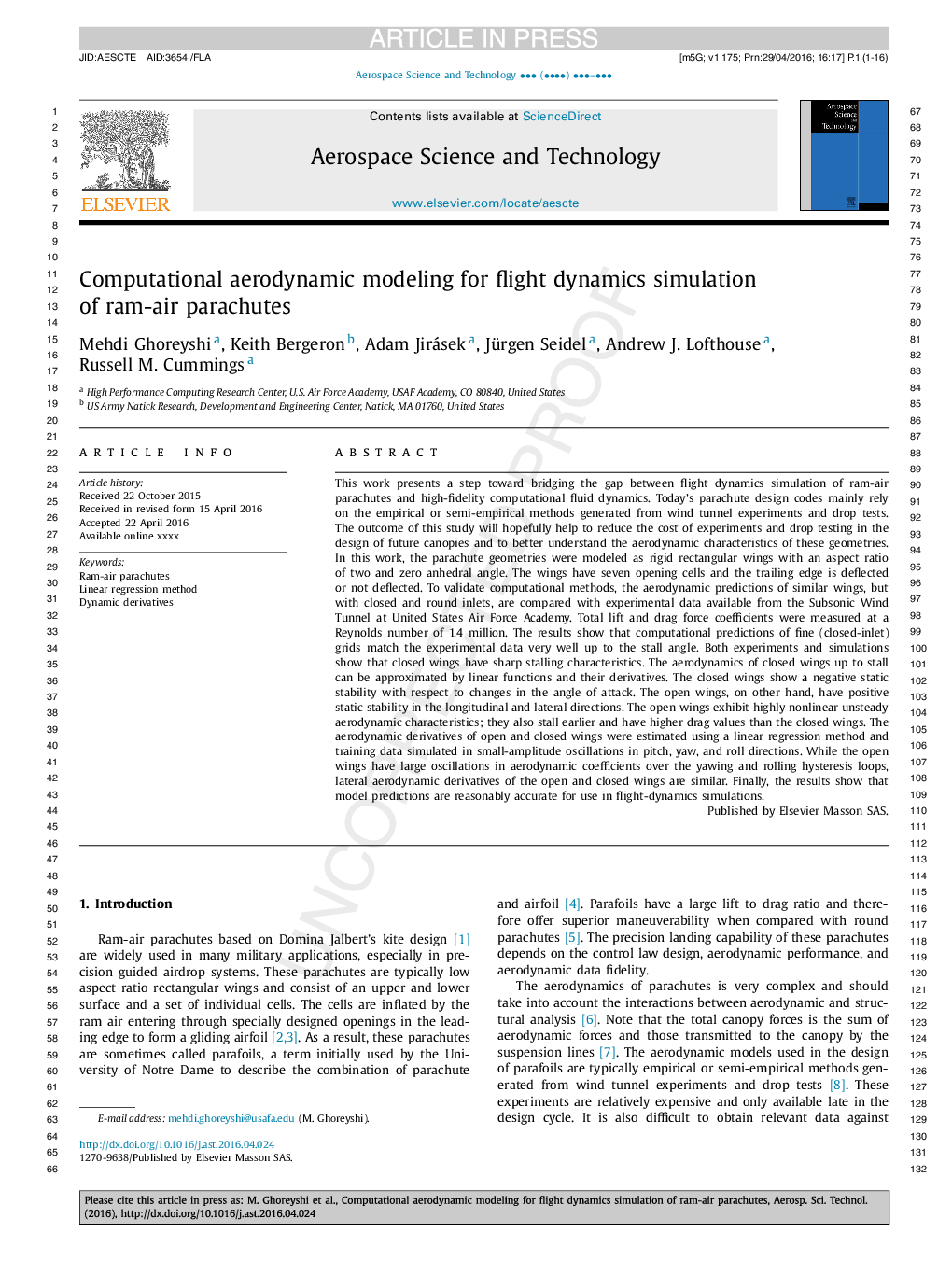| کد مقاله | کد نشریه | سال انتشار | مقاله انگلیسی | نسخه تمام متن |
|---|---|---|---|---|
| 8058598 | 1520080 | 2016 | 16 صفحه PDF | دانلود رایگان |
عنوان انگلیسی مقاله ISI
Computational aerodynamic modeling for flight dynamics simulation of ram-air parachutes
ترجمه فارسی عنوان
مدل سازی آیرودینامیکی محاسباتی برای شبیه سازی دینامیکی پرواز از چتر نجات هواپیما
دانلود مقاله + سفارش ترجمه
دانلود مقاله ISI انگلیسی
رایگان برای ایرانیان
کلمات کلیدی
چتر نجات هواپیما، روش رگرسیون خطی، مشتقات پویا،
ترجمه چکیده
این کار یک گام در جهت برطرف کردن شکاف بین شبیه سازی دینامیکی هواپیماهای بدون سرنشین هواپیما و دینامیک سیالات محاسباتی با وفاداری است. قوانین طراحی چتر نجات امروز به طور عمده بر روش های تجربی یا نیمه تجربی تولید شده از آزمایشات تونل باد و آزمایش های قطره ای تکیه می کنند. نتیجه این مطالعه امیدوارم به کاهش هزینه های آزمایش و تست قطره ای در طراحی تاج های آینده کمک کند و برای درک بهتر ویژگی های آیرودینامیکی این هندسه ها کمک کند. در این کار، هندسه چتر نجات به عنوان بالهای مستطیلی مستطیل شکل با نسبت ابعاد دو و زاویه دیالوگ صفر طراحی شده است. بالها دارای هفت سلول باز هستند و لبه عقب انحراف یا انحراف ندارد. برای اعتبارسنجی روشهای محاسباتی، پیش بینی های آیرودینامیکی بالهای مشابه، اما با ورودی های بسته و دور، با داده های تجربی موجود از تونل باد متعلق به آکادمی نیروی هوایی ایالات متحده مقایسه می شود. ضریب کل نیروی کشش و کشش در یک رینولدز از 1.4 میلیون اندازه گیری شد. نتایج نشان می دهد که پیش بینی های محاسباتی شبکه های خوب (ورودی بسته) داده های آزمایشی را به خوبی با زاویه بسته بندی مطابقت می دهند. هر دو آزمایش و شبیه سازی نشان می دهد که بال های بسته دارای ویژگی های تیز است. آیرودینامیک بال های بسته تا غرق می تواند توسط عملکردهای خطی و مشتقات آن تقریبآور شود. بال های بسته نشان می دهد که ثبات منفی ثابت با توجه به تغییرات در زاویه حمله. از سوی دیگر، بالهای باز دارای ثبات مثبت استاتیک در جهت طولی و جانبی هستند. بال های باز دارای ویژگی های آیرودینامیکی بسیار غیر خطی هستند. آنها همچنین زودتر زده و مقادیر کشیدن بیشتری نسبت به بال های بسته دارند. مشتقات آیرودینامیکی بالهای باز و بسته با استفاده از روش رگرسیون خطی و داده های آموزشی شبیه سازی شده در نوسانات کم دامنه در جهت، ریزش و رول برآورد شد. در حالی که بال های باز دارای نوسان های بزرگی در ضرایب آیرودینامیکی بر روی حلقه های هیسترزیس چرخش و نورد هستند، مشتقات آیرودینامیکی جانبی بال های باز و بسته شبیه هستند. در نهایت، نتایج نشان می دهد که پیش بینی های مدل برای استفاده در شبیه سازی دینامیکی پرواز منطقی دقیق است.
موضوعات مرتبط
مهندسی و علوم پایه
سایر رشته های مهندسی
مهندسی هوافضا
چکیده انگلیسی
This work presents a step toward bridging the gap between flight dynamics simulation of ram-air parachutes and high-fidelity computational fluid dynamics. Today's parachute design codes mainly rely on the empirical or semi-empirical methods generated from wind tunnel experiments and drop tests. The outcome of this study will hopefully help to reduce the cost of experiments and drop testing in the design of future canopies and to better understand the aerodynamic characteristics of these geometries. In this work, the parachute geometries were modeled as rigid rectangular wings with an aspect ratio of two and zero anhedral angle. The wings have seven opening cells and the trailing edge is deflected or not deflected. To validate computational methods, the aerodynamic predictions of similar wings, but with closed and round inlets, are compared with experimental data available from the Subsonic Wind Tunnel at United States Air Force Academy. Total lift and drag force coefficients were measured at a Reynolds number of 1.4 million. The results show that computational predictions of fine (closed-inlet) grids match the experimental data very well up to the stall angle. Both experiments and simulations show that closed wings have sharp stalling characteristics. The aerodynamics of closed wings up to stall can be approximated by linear functions and their derivatives. The closed wings show a negative static stability with respect to changes in the angle of attack. The open wings, on other hand, have positive static stability in the longitudinal and lateral directions. The open wings exhibit highly nonlinear unsteady aerodynamic characteristics; they also stall earlier and have higher drag values than the closed wings. The aerodynamic derivatives of open and closed wings were estimated using a linear regression method and training data simulated in small-amplitude oscillations in pitch, yaw, and roll directions. While the open wings have large oscillations in aerodynamic coefficients over the yawing and rolling hysteresis loops, lateral aerodynamic derivatives of the open and closed wings are similar. Finally, the results show that model predictions are reasonably accurate for use in flight-dynamics simulations.
ناشر
Database: Elsevier - ScienceDirect (ساینس دایرکت)
Journal: Aerospace Science and Technology - Volume 54, July 2016, Pages 286-301
Journal: Aerospace Science and Technology - Volume 54, July 2016, Pages 286-301
نویسندگان
Mehdi Ghoreyshi, Keith Bergeron, Adam Jirásek, Jürgen Seidel, Andrew J. Lofthouse, Russell M. Cummings,
